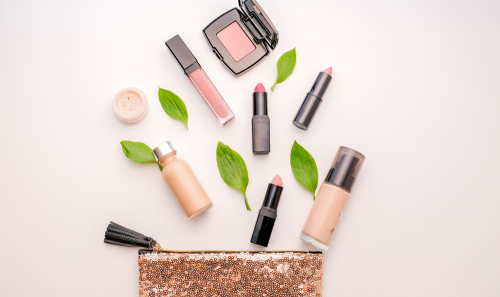A Softer Kind of Glamour
After years as a professional makeup artist, I knew how to sculpt cheekbones, blur imperfections, and perfect a bold lip. But behind the scenes, my skin was quietly asking for something gentler. Foundation felt heavy, mascaras stung my eyes, and lipstick shades I adored left my lips dry and peeling.
That’s when I began to wonder: what if makeup could be beautiful and nourishing? What if it could offer coverage and color, while also respecting the skin beneath?
That’s the promise of organic makeup—beauty grounded in botanicals. These formulations tend to feel lighter, smell softer, and look more like skin. If you’re ready to make the switch, this guide will ease the journey—offering tips, insights, and a few favorites to help you glow with confidence, naturally.
Ad Banner #1
Placeholder for promotional content or advertisement.
What Makes Makeup “Organic”?
Unlike skincare, where certified organic options are more established, the makeup world can be murkier. Some products use the term “organic” loosely—adding a touch of aloe or jojoba and calling it clean. But true organic makeup focuses on whole, plant-based ingredients that are cultivated without synthetic pesticides or harsh chemicals.
Look for labels like USDA Organic, COSMOS, or ECOCERT, which indicate that at least a percentage of the formula comes from certified organic sources. Equally important is what’s not inside: no synthetic dyes, parabens, petrochemicals, artificial fragrance, or silicones.
Instead, you’ll find plant pigments, mineral tints, botanical oils, and wax bases that nourish while enhancing your natural features.
What to Expect When You Make the Switch
Transitioning to organic makeup can feel different at first—but in the best possible way.
Lighter textures: Organic formulas tend to feel more breathable. They won’t create that heavy, mask-like finish but rather enhance your natural radiance.
Earthier scents: Without synthetic fragrance, organic products often smell faintly of the plants they contain—rosehip, cocoa butter, beeswax, lavender. It’s grounding, not perfumey.
More blending, less masking: Natural foundations blend beautifully but may require extra warming in your hands or a damp sponge to melt into skin. They’re about enhancing, not hiding.
Shorter shelf life: Organic products often contain fewer preservatives, so use them within their recommended window and store in a cool, dry place.
Foundational Beauty: Choosing Your Base
Finding your perfect organic foundation is like finding the right herbal tea—it’s personal and worth the patience. Here are some gentle options I’ve used and loved:
Cream or stick foundations with oils like jojoba and argan offer buildable coverage with a dewy finish. They’re ideal for dry or mature skin.
Tinted moisturizers or serum foundations are perfect for minimal, everyday looks. They often contain botanical extracts like aloe vera, green tea, or calendula.
Mineral powders made with mica and zinc oxide give a soft-focus effect, but choose finely milled options to avoid dryness.
Some brands to explore: RMS Beauty, ILIA, 100% Pure, Ere Perez, and Alima Pure. Each offers varying finishes—from glowy to matte—and skin-nourishing ingredients that support rather than stress the skin.
Color from the Garden: Natural Lipsticks & Cheek Tints
One of the most joyful discoveries in organic makeup is lipstick. Imagine buttery textures tinted with beetroot, plum, or rose clay, and scented faintly with vanilla bean or cocoa.
Look for lip and cheek products made with:
-
Cocoa butter, mango butter, or castor oil for moisture
-
Natural waxes like candelilla or beeswax for structure
-
Mineral tints or fruit pigments for color
Cream blushes and multi-sticks tend to be the most forgiving, especially on sensitive skin. They blend with the warmth of your fingers and give that “just came in from a walk” flush.
For a sheer, nourishing wash of color, I adore lip balms tinted with alkanet root or rose clay. They feel like skincare in lipstick’s clothing.
Ad Banner #2
Placeholder for promotional content or advertisement.
The Eyes Have It: Lashes, Lids & Brows
Eyes can be especially reactive, so switching to organic formulas often brings immediate relief.
Mascaras with black tea, charcoal, or mineral pigments offer lift and definition without the sting. Beeswax, shea butter, and vitamin E help condition lashes. Expect a more natural look—less va-va-voom, more fluttery and soft.
Eyeshadows in the organic space often come in earthy tones—soft taupes, shimmering golds, mossy greens—pigmented with minerals and fruit. They blend best when layered gently.
Brow balms or powders use clays and oils to tint and tame without flaking or stiffness.
While wear time may not rival the waterproof, bulletproof formulas of conventional makeup, you’ll gain peace of mind—especially around such a delicate area.
Tips for a Smooth Transition
Replace slowly: Start with the product you use most—maybe your foundation or lipstick—and build from there. This lets your skin adjust and gives you time to explore.
Prep your skin well: Organic makeup loves hydrated skin. Use a lightweight facial oil or hydrating mist before applying.
Embrace imperfection: Organic makeup invites you to soften, to glow, to look like you. Let go of the need for total coverage and invite radiance instead.
A More Honest Kind of Beauty
For me, the transition to organic makeup wasn’t just about ingredients—it was about mindset. About choosing products that feel like an extension of skincare, not a mask. About letting my freckles show, my skin breathe, and my features shine through in their own way.
There’s something tender about applying a rose-tinted balm or a mineral blush and knowing it came from the earth—that it’s been made thoughtfully, and that it’s honoring not just your appearance, but your well-being.
So if you’re making the switch, go gently. Let your makeup become a part of your self-care ritual, not just your routine. And know that beauty—real beauty—glows brightest when it’s nourished from within.



























